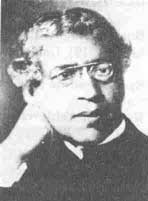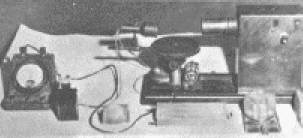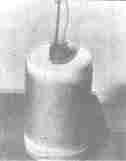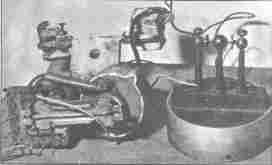
Born 30 November 1858 (Mymensingh, Bangladesh)
Died 23 November 1937;
D.Sc. (1896), University of London, UK
Specialization:
Optics, Electromagnetic Radiation,
Plant Physiology
 |
Jagdish
Chandra Bose (1858-1937) Born 30 November 1858 (Mymensingh, Bangladesh) Died 23 November 1937; D.Sc. (1896), University of London, UK Specialization: Optics, Electromagnetic Radiation, Plant Physiology |
Sir J.C. Bose did his original scientific work in the area of Microwaves.
He made his own equipment by employing an illiterate tin-smith whom he trained up to do
the job for him. He produced extremely short waves and done considerable improvement upon
Hertz's detector of electric waves. He produced a compact appratus for generating
electromagnetic waves of wavelengths 25 to 5 mm and studying their quasioptical
properties, such as refraction, polarization and double refraction. These could be
demonstrated by his compact apparatus mounted on an ordinary spectrometer table. The most
satisfactory polarizers and analyzers were made out of pressed jute fibres or books with
laminated pages. He could even produce rotation of plane of polarization by transmission
of electric rays through bundle of twisted jute fibres. The originality and simplicity of
his apparatus were its remarkable features. Bose's research on response in living and
non-living led to some significant findings: in some animal tissues like muscles,
stimulation produces change in form as well as electrical excitation, while in other
tissues (nerves or retina), stimulation by light produces electric changes only but no
change of form. He showed that not only animal but vegetable tissues under different kinds
of stimuli-mechanical, application of heat, electric shock, chemicals, drugs- produce
similar electric responses.

The Microwave
receiver developed by Bose
The receiver which was
made by Bose represented a great advance compared to that of even Hertz. He was
said to be the first to employ a semi-conductor like galena as a self recovering detector
of electric rays.

The Galena detector developed by
Bose
Bose could successfully produce a flash of radiation by pressing a key; the waves
were only about half an inch in length; while the receiver was so sensitive that it
responded to the feeblest electric reaction. In the year 1895, at the Presidency
College, Calcutta, Bose demonstrated the possibility of signalling by ether waves, message
to a distance. In the Calcutta Town Hall also, before a large gathering, he transmitted
waves through the body of the chairman of the meeting, the Lieutant Governor of Bengal,
and then through a solid wall, displacing a heavy weight, a mine placed in closed room.

The Microwave transmitter developed by Bose
Nearly 100 years
after Guglielmo Marconi's first transatlantic wireless communication, a group of
scientists of the US-based Institute of Electronics and Electrical
Engineers (IEEE) reported that -"the origin and first major use of the solid
state diode detector devices led to the discovery that the first transatlantic wireless
signal in Marconi's world famous experiment was received by Marconi using the
iron-mercury-iron coherer with a telephone detector invented by Sir J.C.Bose in
1898".
Bose's invention of the "mercury coherer with a telephone"
which Marconi used was published in the Proceedings of the Royal Society, London,
on April 27, 1899, over two years before Marconi's first wireless communication
on December 12, 1901, from NewFoundland, now in Canada.
Investigations by the IEE group show that both Bose and Marconi were in London in
1896-97. The Italian was conducting wireless experiments for the British post
office and Bose was on a lecture tour. Both the scientists were interviewed by
McClure's Magazine (now defunct) in March 1897.
In the interview, Bose came out with high praise for
Marconi, then under attack from established British scientists who
doubted his credentials. Marconi never could make it to college because of his poor high
school record. Bose also said he was not interested in commercial telegraphy and that
others could use his research work.
In 1899, Bose unveiled his invention of the mercury coherer with the telephone detector in
a paper at the Royal Society.
Brilliant Marconi quickly grasped the commercial importance of Bose's invention and began
to explore it secretly. His childhood friend Luigi Solari started experimentally with
Bose's invention and presented Marconi with a slightly modified design in the summer of
1901 for use in the upcoming transatlantic experiment.
The Chronology:
1895
J.C. Bose ignites gunpoder and rings a bell at a distance using electromagnetic waves,
proving for the first time in history communication
signals can be sent without using wires.
1896
Bose is in London on a lecture tour and so is Marconi, who is
conducting wireless experiments for the British post office. In an interview, Bose also
says he is not interested in commercial telegraphy and others can use his research work.
1899
Bose announces the invention of the "iron-mercury-iron
coherer with telephone detector" in a paper presented at Royal Society, London.
Sources:
" Discovery of Millimeter Waves by Sir J.C. Bose" by Prof. P.K. Ray, Director,
Bose Institute, Calcutta : Hamfest India'96 Souvenir
" Bose invented Marconi's wireless"- by Mita Mukherjee
: The Telegraph, Calcutta, Saturday 1 November, 1997.
"Fellows of the Indian National Science Academy" Vol.1 (Diamond Jubilee
Compendium),1994, Indian National Science Academy. pp 121-122